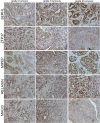Five markers useful for the distinction of canine mammary malignancy
- PMID: 23844591
- PMCID: PMC3750412
- DOI: 10.1186/1746-6148-9-138
Five markers useful for the distinction of canine mammary malignancy
Abstract
Background: Spontaneous canine mammary tumors constitute a serious clinical problem. There are significant differences in survival between cases with different tumor grades. Unfortunately, the distinction between various grades is not clear. A major problem in evaluating canine mammary cancer is identifying those, that are "truly" malignant. That is why the aim of our study was to find the new markers of canine malignancy, which could help to diagnose the most malignant tumors.
Results: Analysis of gene expression profiles of canine mammary carcinoma of various grade of malignancy followed by the boosted tree analysis distinguished a `gene set`. The expression of this gene set (sehrl, zfp37, mipep, relaxin, and magi3) differs significantly in the most malignant tumors at mRNA level as well as at protein level. Despite this `gene set` is very interesting as an additional tool to estimate canine mammary malignancy, it should be validated using higher number of samples.
Conclusions: The proposed gene set can constitute a `malignancy marker` that could help to distinguish the most malignant canine mammary carcinomas. These genes are also interesting as targets for further investigations and therapy. So far, only two of them were linked with the cancer development.
Figures



Similar articles
-
Expression of inflammation-mediated cluster of genes as a new marker of canine mammary malignancy.Vet Res Commun. 2013 Jun;37(2):123-31. doi: 10.1007/s11259-013-9554-1. Epub 2013 Feb 24. Vet Res Commun. 2013. PMID: 23435839 Free PMC article.
-
The combined expression pattern of BMP2, LTBP4, and DERL1 discriminates malignant from benign canine mammary tumors.Vet Pathol. 2010 May;47(3):446-54. doi: 10.1177/0300985810363904. Epub 2010 Apr 7. Vet Pathol. 2010. PMID: 20375427
-
Possible role of Snail expression as a prognostic factor in canine mammary neoplasia.J Comp Pathol. 2012 Aug-Oct;147(2-3):121-8. doi: 10.1016/j.jcpa.2011.12.002. Epub 2012 Jan 31. J Comp Pathol. 2012. PMID: 22297072
-
Research progress of good markers for canine mammary carcinoma.Mol Biol Rep. 2023 Dec;50(12):10617-10625. doi: 10.1007/s11033-023-08863-x. Epub 2023 Nov 9. Mol Biol Rep. 2023. PMID: 37943402 Review.
-
Exploring the role of microRNAs as diagnostic and prognostic biomarkers in canine mammary tumors.Geroscience. 2024 Dec;46(6):6641-6657. doi: 10.1007/s11357-024-01260-7. Epub 2024 Jul 2. Geroscience. 2024. PMID: 38954129 Free PMC article. Review.
Cited by
-
Programmed Death-Ligand (PD-L1), Epidermal Growth Factor (EGF), Relaxin, and Matrix Metalloproteinase-3 (MMP3): Potential Biomarkers of Malignancy in Canine Mammary Neoplasia.Int J Mol Sci. 2024 Jan 18;25(2):1170. doi: 10.3390/ijms25021170. Int J Mol Sci. 2024. PMID: 38256245 Free PMC article.
-
Establishment and Partial Characterization of Canine Mammary Tumor Cell Lines.Animals (Basel). 2025 Jul 7;15(13):1991. doi: 10.3390/ani15131991. Animals (Basel). 2025. PMID: 40646890 Free PMC article.
-
The Novel Diagnostic Techniques and Biomarkers of Canine Mammary Tumors.Vet Sci. 2022 Sep 26;9(10):526. doi: 10.3390/vetsci9100526. Vet Sci. 2022. PMID: 36288138 Free PMC article. Review.
-
Exploiting cancer genomics in pet animals to gain advantage for personalized medicine decisions.J Appl Genet. 2014 Aug;55(3):337-41. doi: 10.1007/s13353-014-0206-0. Epub 2014 Apr 11. J Appl Genet. 2014. PMID: 24722858 Free PMC article. No abstract available.
-
ESF1 and MIPEP proteins promote estrogen receptor-positive breast cancer proliferation and are associated with patient prognosis.Clin Proteomics. 2024 Jul 15;21(1):50. doi: 10.1186/s12014-024-09502-8. Clin Proteomics. 2024. PMID: 39004717 Free PMC article.
References
-
- Polton G. Mammary tumors in dogs. Irish Vet J. 2009;62(1):50–56.
-
- Król M, Pawłowski KM, Otrębska D, Motyl T. DNA microarrays – future in oncology research and therapy. JPCCR. 2008;2:091–096.
Publication types
MeSH terms
Substances
LinkOut - more resources
Full Text Sources
Other Literature Sources
Molecular Biology Databases

